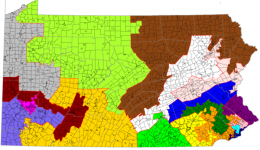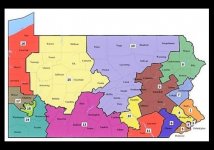February 19, 2018
Pennsylvanias's constitutional crisis
By Frank Ryan
https://www.americanthinker.com/blog/2018/02/pennsylvanias_constitutional_crisis_.html#ixzz57Z98stL3
In a repeat of the state's extraordinary role in the 2016 presidential election, this year, Pennsylvania will be the center of a serious constitutional challenge.
At stake may be the entire congressional balance of power between Democrats and Republicans. Democrats in PA are attempting to do through the courts what they were not able to do at the ballot box. They are assuming that the woes of their cause are due to redistricting, not to failed policies repudiated by the electorate.
Trump's stunning statewide victory in Pennsylvania in 2016 had absolutely nothing to do with gerrymandering.
As background, the Supreme Court of Pennsylvania in 2018 ruled that the 2012 redistricting of Pennsylvania's congressional districts was unconstitutional. The Court gave the legislature until February 9 to submit a plan of redistricting to the governor for approval. The governor would then have until February 15 to accept or reject the map.
The governor has rejected the map, and in its decision, the Supreme Court reserved the right to draw the boundaries of redistricting of its own accord or to select one of many competing plans.
Currently, Pennsylvania is represented by 13 Republicans and five Democrats. The governor's perspective is that it is "fairer" to have approximately equal representation of Democrats and Republicans despite extreme "clustering" of Democrats in Philadelphia, Pittsburgh, and other cities. The commonwealth has been known for decades to have a very conservative "T" region in which only the anchor cities in the Southeast and Southwest provide traditionally solid support for a liberal agenda.
The current map is without a doubt unusual, and most can understand the reasons behind the court challenge. The map does not look "normal" due to the lines drawn, and so there were legal challenges to reverse it in 2017. The lawsuit was decided after President Trump was elected. The same maps were approved by the Supreme Court of Pennsylvania in 2013, which found them to be constitutional.
Since the 2016 election, the money spent to sway the Supreme Court has been staggering. Three Democratic Supreme Court justices won election in November 2015, thereby giving the Court a balance of five Democrats and two Republicans. This shift in the balance of power on the court set the stage for the constitutional crisis playing out in Harrisburg.
As soon as the Supreme Court intercedes and adopts a new map, a constitutional crisis immediately ensues. Seldom in our nation's history has a state Supreme Court usurped the constitutional role of the legislature in drawing congressional boundaries.
The importance of these maps to our nation and its balance of power is profound. Should the districts be gerrymandered by the Court's Democratic majority, sufficient seats may flip to the Democrats to facilitate a shift in power in Washington D.C., potentially disenfranchising millions of Pennsylvanians as well as derailing the Trump agenda.
By writing the decision the way it did, the Court is likely violating the Constitution in that it is the responsibility of the legislature to draw the map. Additionally, the new maps, due to court-ordered time constraints, did not allow time for the legislature to vote on them.
The Supreme Court decision will be one of many constitutional challenges in Pennsylvania in the weeks ahead. It is likely that there will be a petition to the U.S. Supreme Court to vacate the PA Court's decision, further delaying the congressional primary elections.
It is also likely that there will be a move to impeach the justices engaged in redistricting without the legislature's approval.
None of these outcomes is helpful, but once again, Pennsylvania will play a pivotal role in our nation's history in the days ahead.
The damage to our republic when a judiciary not only legislates from the bench, but manipulates elections makes the interference by Russians pale in comparison.
Frank Ryan, CPA, USMCR (ret.) represents the 101st District in the PA House of Representatives. He is a retired Marine reserve colonel and a CPA and specializes in corporate restructuring. He has served on numerous boards of publicly traded and non-profit organizations. He can be reached at FRYAN1951@aol.com.
Pennsylvanias's constitutional crisis
By Frank Ryan
https://www.americanthinker.com/blog/2018/02/pennsylvanias_constitutional_crisis_.html#ixzz57Z98stL3
In a repeat of the state's extraordinary role in the 2016 presidential election, this year, Pennsylvania will be the center of a serious constitutional challenge.
At stake may be the entire congressional balance of power between Democrats and Republicans. Democrats in PA are attempting to do through the courts what they were not able to do at the ballot box. They are assuming that the woes of their cause are due to redistricting, not to failed policies repudiated by the electorate.
Trump's stunning statewide victory in Pennsylvania in 2016 had absolutely nothing to do with gerrymandering.
As background, the Supreme Court of Pennsylvania in 2018 ruled that the 2012 redistricting of Pennsylvania's congressional districts was unconstitutional. The Court gave the legislature until February 9 to submit a plan of redistricting to the governor for approval. The governor would then have until February 15 to accept or reject the map.
The governor has rejected the map, and in its decision, the Supreme Court reserved the right to draw the boundaries of redistricting of its own accord or to select one of many competing plans.
Currently, Pennsylvania is represented by 13 Republicans and five Democrats. The governor's perspective is that it is "fairer" to have approximately equal representation of Democrats and Republicans despite extreme "clustering" of Democrats in Philadelphia, Pittsburgh, and other cities. The commonwealth has been known for decades to have a very conservative "T" region in which only the anchor cities in the Southeast and Southwest provide traditionally solid support for a liberal agenda.
The current map is without a doubt unusual, and most can understand the reasons behind the court challenge. The map does not look "normal" due to the lines drawn, and so there were legal challenges to reverse it in 2017. The lawsuit was decided after President Trump was elected. The same maps were approved by the Supreme Court of Pennsylvania in 2013, which found them to be constitutional.
Since the 2016 election, the money spent to sway the Supreme Court has been staggering. Three Democratic Supreme Court justices won election in November 2015, thereby giving the Court a balance of five Democrats and two Republicans. This shift in the balance of power on the court set the stage for the constitutional crisis playing out in Harrisburg.
As soon as the Supreme Court intercedes and adopts a new map, a constitutional crisis immediately ensues. Seldom in our nation's history has a state Supreme Court usurped the constitutional role of the legislature in drawing congressional boundaries.
The importance of these maps to our nation and its balance of power is profound. Should the districts be gerrymandered by the Court's Democratic majority, sufficient seats may flip to the Democrats to facilitate a shift in power in Washington D.C., potentially disenfranchising millions of Pennsylvanians as well as derailing the Trump agenda.
By writing the decision the way it did, the Court is likely violating the Constitution in that it is the responsibility of the legislature to draw the map. Additionally, the new maps, due to court-ordered time constraints, did not allow time for the legislature to vote on them.
The Supreme Court decision will be one of many constitutional challenges in Pennsylvania in the weeks ahead. It is likely that there will be a petition to the U.S. Supreme Court to vacate the PA Court's decision, further delaying the congressional primary elections.
It is also likely that there will be a move to impeach the justices engaged in redistricting without the legislature's approval.
None of these outcomes is helpful, but once again, Pennsylvania will play a pivotal role in our nation's history in the days ahead.
The damage to our republic when a judiciary not only legislates from the bench, but manipulates elections makes the interference by Russians pale in comparison.
Frank Ryan, CPA, USMCR (ret.) represents the 101st District in the PA House of Representatives. He is a retired Marine reserve colonel and a CPA and specializes in corporate restructuring. He has served on numerous boards of publicly traded and non-profit organizations. He can be reached at FRYAN1951@aol.com.


